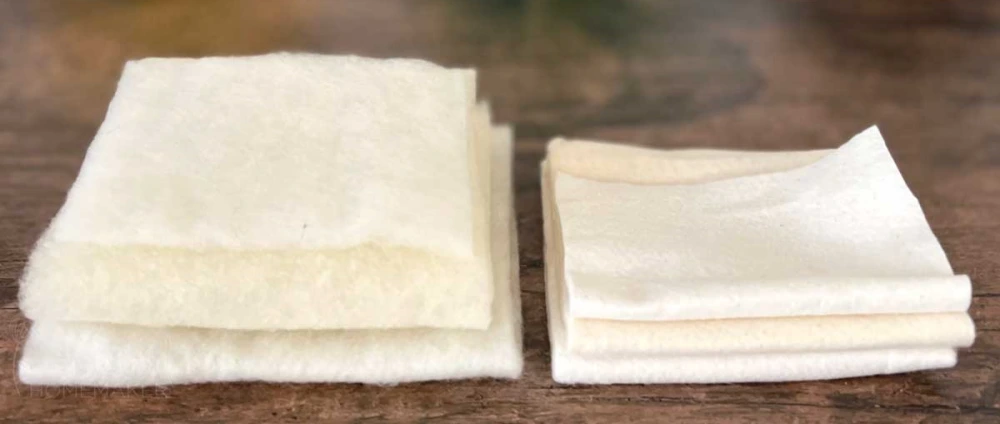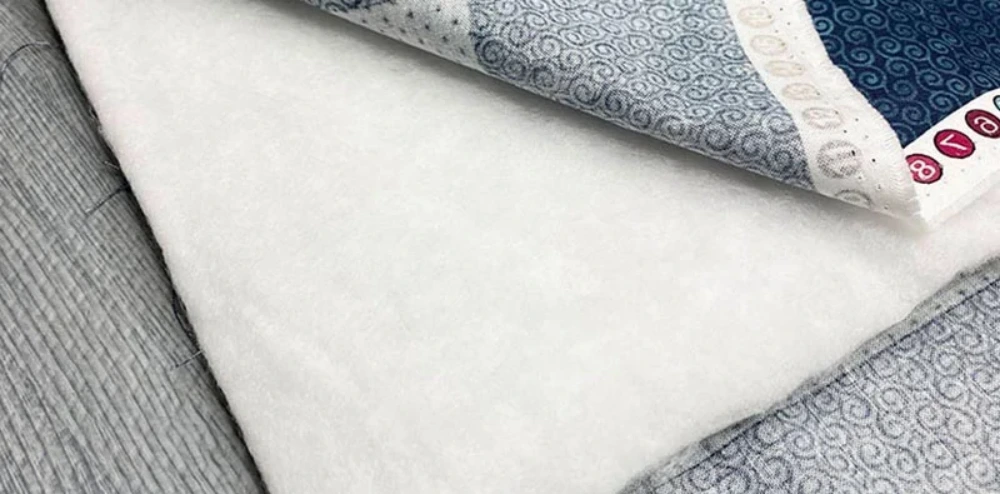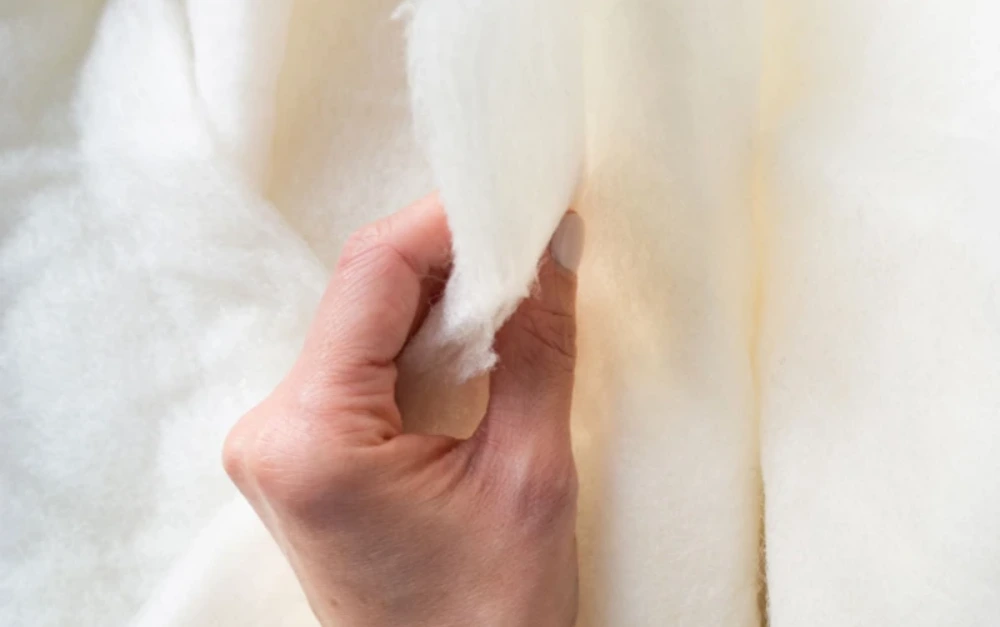You don’t need to iron to remove wrinkles from quilt batting. Most quilters lay batting flat, smooth it by hand, and let it rest for up to two days. Tumbling batting in a dryer with no heat or low heat and a damp washcloth works well, especially for bulk quilt batting.
Hanging, batting, or spritzing it with water helps wrinkles relax. Wrinkle releasers can help with synthetic blends. Ironing isn’t recommended, since some fibers in quilt batting can scorch or shrink.
Key Takeaways
Remove wrinkles by laying batting flat and smoothing it by hand, then let it rest for up to two days to relax the fibers naturally.
Use a dryer on low or no heat with a damp cloth to quickly remove wrinkles, but avoid high heat to prevent damage, especially on synthetic fibers.
Store batting rolled or hung to prevent deep creases and keep fibers relaxed for easier use later.
Avoid ironing quilt batting because heat can scorch, melt, or shrink fibers depending on the material.
Choose wrinkle removal methods based on fiber type, and always test new methods on a small area to protect your batting.
Why Wrinkles Form in Quilt Batting?

Packaging and Storage Effects
When you open a new package of quilt batting, you might notice a few stubborn wrinkles. This happens because manufacturers fold or roll batting tightly to save space during shipping.
The longer the batting stays packed, the deeper those creases can get. If you store batting in a closet or under a bed, it can pick up extra wrinkles from being pressed or squished by other items.
You can avoid some of these issues by storing batting loosely. Try rolling it instead of folding, or hang it in a closet if you have the space. This helps keep the fibers relaxed and makes it easier to smooth out wrinkles when you’re ready to use the batting in your next quilt.
Tip: If you buy batting in bulk, separate it into smaller pieces and store each one in a breathable bag. This keeps your batting fresh and less prone to deep creases.
Risks of Ironing
You might think ironing is the quickest way to get rid of wrinkles in quilt batting. For some fibers, that’s true, but you need to be careful. Cotton batting can handle a little heat, especially if you iron it after it’s inside a finished quilt. The fibers stay strong, and you won’t damage the batting.
Polyester batting is a different story. If you use an iron on polyester, the heat can actually melt the fibers. This doesn’t just flatten the batting—it can fuse the layers and ruin your quilt.
The top and bottom fabrics might stick to the batting, leaving you with a stiff, plastic-like mess. That’s why most quilters avoid ironing polyester or synthetic blends.
So, always check the label before you reach for the iron. When in doubt, use safer methods like airing out or using a dryer on low heat. Your quilt batting will thank you!
Remove Wrinkles from Quilt Batting: Airing Out

Step-by-Step Guide
Airing out is one of the safest and easiest ways to remove wrinkles from quilt batting. You don’t need any fancy tools—just a clean, flat surface and a little patience. Here’s how you can do it:
Unfold the Batting
Take your batting out of the package and gently shake it out. Lay it flat on a clean surface like a bed, table, or even a large section of floor. Make sure the area is free from dust and pet hair.Smooth Out Wrinkles by Hand
Use your hands to gently pat and smooth the batting. Don’t pull or stretch it. Just work out the biggest creases with light pressure.Let the Batting Rest
Leave the batting flat for several hours. For best results, let it rest overnight or up to two days. Most wrinkles will relax and disappear on their own during this time.Flip for Even Results
If you notice stubborn wrinkles, flip the batting over after a few hours. This helps both sides relax evenly.Check Before Quilting
Before you start your quilt, check the batting for any remaining creases. If you still see a few, repeat the process or try a gentle mist of water to help the fibers relax.
Tip: If you’re in a hurry, you can hang the batting over a railing or shower rod. Gravity will help relax batting and smooth out wrinkles faster.
Best for Fanda Fabrics Cotton Quilt Batting
Fanda Fabrics Cotton Quilt Batting works perfectly with the airing out method. Cotton fibers respond well to being laid flat and left to rest. You’ll notice that the natural loft returns as the batting relaxes. This method keeps the batting soft and even, so your quilt looks smooth and professional.
If you use Fanda Fabrics Cotton Quilt Batting, you get the benefit of high-quality, breathable material that’s easy to handle. Whether you choose thin or ultra-thin options, airing out helps you prepare the batting without risking shrinkage or damage.
You can find more details about these products on the Fanda Fabrics website.
Tips and Precautions
For Large Batting Pieces:
If you have king or queen-size batting, fold it loosely and lay it across a bed or large table. You can also drape it over several chairs lined up in a row.For Thick or High-Loft Batting:
Thicker batting may take longer to relax. Give it extra time—up to two days—to fully remove wrinkles from quilt batting.For Small Batting Pieces:
Smaller pieces usually relax in just a few hours. You can even hang them on a clothesline for quick results.Avoid Moisture:
Don’t use too much water or steam, especially with cotton or blends. Too much moisture can cause the fibers to clump or shrink.Store Properly:
After airing out, roll the batting instead of folding it. This helps prevent new wrinkles from forming before you use it in your next quilt.
Note: Always check the care instructions for your specific batting. Some specialty blends may need extra care.
Airing out is a gentle, reliable way to prepare your batting. With a little time and these simple steps, you can easily remove wrinkles from quilt batting and get ready for your next quilting project.
Dryer Method to Remove Wrinkles
If you want a quick and effective way to remove wrinkles from quilt batting, the dryer method is a favorite among quilters. You don’t need fancy equipment—just your home dryer and a few simple steps. This method works especially well for large or bulky batting that’s hard to lay flat.
No-Heat and Low-Heat Options
You can use either a no-heat or low-heat setting to safely remove wrinkles from quilt batting. Here’s how you do it:
Place the batting in your dryer. Make sure it has enough room to tumble freely.
Add a clean, damp washcloth or towel. This helps create gentle steam, which relaxes the fibers and smooths out creases.
Set your dryer to the lowest heat or no-heat (air fluff) setting. High heat can damage some fibers, so always start low.
Tumble the batting for 10–20 minutes. Check it halfway through and gently shake it out if needed.
If you see stubborn wrinkles, repeat the process or let the batting rest flat after tumbling.
Remove the batting while it’s still slightly damp. Lay it flat or hang it to finish air drying. This prevents shrinkage and keeps the fibers fluffy.
Tip: Toss in a couple of clean tennis balls or dryer balls. They help fluff the batting and prevent clumping during the tumble.
This method is gentle and works for most cotton, bamboo, and polyester blends. You’ll see wrinkles disappear without risking damage to your quilt batting.
Using Fanda Fabrics Bulk Quilt Batting

If you work with Fanda Fabrics Bulk Quilt Batting or other large pieces, the dryer method is a real time-saver. Bulk batting often comes tightly packed, so wrinkles can be deep. The dryer helps relax the fibers quickly, even for king or queen-size batting.
Cut your bulk batting into manageable sections if needed. This helps each piece tumble evenly.
Use the air fluff or low-heat setting to protect the batting’s structure.
After you tumble in the dryer, lay each piece flat to finish drying and smoothing.
Fanda Fabrics Bulk Quilt Batting holds up well to this process. The premium materials stay soft and lofty, so your finished quilt looks and feels professional. You can find more about these products on the Fanda Fabrics website.
Safety Tips
Not all batting fibers handle heat the same way. Here’s what you need to know before you use your dryer:
Fiber Type | Dryer Setting | Special Notes |
|---|---|---|
Cotton | Low or No Heat | Remove while damp, air dry to finish |
Polyester | No Heat (Air Fluff) | Avoid heat to prevent melting |
Bamboo | Low or No Heat | Gentle tumble, finish by air drying |
Silk | Avoid Dryer | Air out or hang only, never use heat |
Wool | Avoid Dryer | Can shrink or felt, use airing method instead |
Always check the care label on your batting before you start.
Never use high heat, especially with polyester, silk, or wool. High temperatures can melt, shrink, or damage delicate fibers.
If you’re unsure, test a small piece first. This helps you avoid surprises on your main project.
Don’t overload your dryer. Batting needs space to tumble and relax.
Note: For specialty batting like silk or wool, skip the dryer and use the airing out or hanging method instead. This keeps your batting in top shape.
The dryer method gives you a fast, easy way to remove wrinkles from quilt batting. With the right settings and a little care, you’ll have smooth, fluffy batting ready for your next quilting masterpiece.
Hanging, Spritzing, and Wrinkle Releasers
Hanging and Gravity
You can let gravity do the hard work for you. When you hang the batting over a shower rod, curtain rod, or even a clothesline, the weight of the fabric helps wrinkles fall out naturally. This method works best if you have space to let the batting hang freely.
You just need to make sure the area is clean and dry. If you want faster results, try gently smoothing the batting with your hands after you hang it. Most quilters find that leaving batting to hang overnight gives the fibers time to relax.
Tip: For large pieces, fold the batting loosely and drape it over several chairs. This helps gravity work on every section.
Spritzing with Water
Spritzing quilt batting with water speeds up the wrinkle removal process. You can use a spray bottle to mist the batting lightly. Don’t soak it—just a fine mist will do. After spritzing, you can hang batting or tumble it in the dryer on low heat for 10–15 minutes. Many quilters add a damp washcloth and woolly balls to the dryer for even better results.
This method is much quicker than waiting days for wrinkles to relax on their own. You’ll notice the batting feels warm, soft, and smooth right after drying. If you spread the batting out immediately, you prevent new wrinkles from forming.
Using Commercial Wrinkle Releasers
If you work with synthetic blends, a commercial wrinkle releaser can save you time. These sprays help loosen fibers and make wrinkles disappear fast. You just spray the releaser on the batting, smooth it out by hand, and let it air dry.
Always test the spray on a small area first to make sure it doesn’t affect the texture. Wrinkle releasers work best for polyester and blends, but you should avoid them on delicate fibers like silk or wool.
Fiber Type | Wrinkle Releaser Use | Notes |
|---|---|---|
Polyester/Blend | Yes | Test first, air dry |
Cotton | Sometimes | Use sparingly |
Silk/Wool | No | Use gentle methods only |
Fanda Fabrics Silk Quilt Batting Care
Silk quilt batting needs extra care. You should never use heat, steam, or commercial sprays on silk. The best way is to lay it flat or hang the batting in a clean, dry space. Let gravity work slowly.
If you see wrinkles, smooth them gently with your hands. Fanda Fabrics Silk Quilt Batting stays soft and luxurious when you treat it gently. You can find more tips for silk batting care on the Fanda Fabrics website.
Removing Wrinkles: Fiber-Specific Tips
Cotton and Blends
When you work with cotton or cotton-blend batting, you want to keep things gentle. Most quilters skip pre-washing because it can thin the batting and cause uneven spots. If you see wrinkles, lightly spritz the batting with water and toss it in the dryer on a no-heat or air-fluff cycle for a few minutes.
This method works well for Fanda Fabrics Cotton Quilt Batting. You get a smooth finish without risking shrinkage or damaging the fibers. Remember, cotton batting can shrink about 5%, so factor that into your quilt size if you want a crisp, modern look. Always check the care label before trying any new method.
Tip: Avoid using this method on batting with water-soluble fusible layers, since moisture can affect the adhesive.
Polyester and Synthetics
Polyester batting often arrives with wrinkles from packaging, but it’s easy to handle. Just unfold the batting and let it rest overnight. The high loft and stability help it flatten out on its own. If you need faster results, use the dryer on an air-fluff setting with a damp towel.
Polyester doesn’t shrink much, so you don’t have to worry about changing the size of your quilt. For stubborn creases, a commercial wrinkle releaser can help, but always test a small area first.
Silk and Specialty Batting
Silk batting feels luxurious but needs extra care. Never use heat or steam, and avoid washing or putting it in the dryer. The best way to remove wrinkles is to lay the batting flat or hang it in a clean, dry space.
Smooth it gently with your hands. If you use Fanda Fabrics Silk Quilt Batting, you’ll notice it relaxes beautifully with just a little patience. For delicate fibers, always handle with care and avoid pressing with a hot iron.
Bamboo and Eco-Friendly Options
Bamboo batting is soft and sustainable, but you want to treat it gently. If you need to wash it, use cool water and a mild detergent. Soak for about 15 minutes, then roll the batting in a towel to remove extra water. Lay it flat in the shade to dry. This method keeps the fibers strong and prevents harsh wrinkles.
Avoid pre-washing unless you want a vintage, puckered look in your quilt. Fanda Fabrics offers eco-friendly batting options that respond well to these gentle methods.
Safety Tips for All Batting:
Always check care instructions before removing wrinkles.
Test any new method on a small section first.
Keep batting rolled for storage to prevent deep creases.
Use quality materials like Fanda Fabrics for easier wrinkle management.
Conclusion
You have plenty of safe ways to get wrinkles out of quilt batting. Always let batting relax naturally, use a low-heat dryer, or spritz and smooth by hand. Never rush with high heat or skip testing a small area first. Here’s a quick guide:
Do’s | Don’ts |
|---|---|
Use low heat or air dry | Iron on high heat |
Test a small section | Skip care instructions |
Smooth by hand | Overload the dryer |
Choose the right method for your fiber type. For the best results, try Fanda Fabrics batting and check out their website for more quilting tips and resources!
FAQ
How do you store batting to prevent wrinkles?
You should roll your batting instead of folding it. Store it in a breathable bag or hang it in a closet. This keeps the fibers relaxed and helps you avoid deep creases.
Can you iron quilt batting if you’re in a hurry?
You really shouldn’t. Ironing can scorch or melt some fibers. Try airing out, using a dryer on low or no heat, or spritzing with water for quick results.
What if wrinkles remain after using these methods?
Don’t worry! Some creases need a little more time. Lay the batting flat again or hang it overnight. Most wrinkles will relax with patience and gentle handling.
Is it safe to use commercial wrinkle releasers on all batting types?
No, it isn’t. Only use wrinkle releasers on polyester or blends. Always test a small spot first. Avoid them on silk, wool, or specialty fibers.
Do you need to pre-wash batting before quilting?
You don’t have to pre-wash most batting. Pre-washing can cause shrinkage or change the texture. Just smooth out wrinkles and follow the care instructions for your specific batting.
